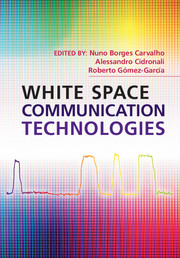Book contents
- Frontmatter
- Contents
- List of contributors
- Preface
- List of abbreviations
- Part I White space technology signal processing and digital design
- Part II Adaptable receivers for white space technologies
- 4 Reconfigurable RF front-ends for cognitive and software-defined radio
- 5 Filtering stages for white space cognitive/software-defined radio receivers
- 6 Subsampling multi-standard receiver design for cognitive radio systems
- Part III Adaptable transceivers for white space technologies
- Index
- References
5 - Filtering stages for white space cognitive/software-defined radio receivers
from Part II - Adaptable receivers for white space technologies
Published online by Cambridge University Press: 05 October 2014
- Frontmatter
- Contents
- List of contributors
- Preface
- List of abbreviations
- Part I White space technology signal processing and digital design
- Part II Adaptable receivers for white space technologies
- 4 Reconfigurable RF front-ends for cognitive and software-defined radio
- 5 Filtering stages for white space cognitive/software-defined radio receivers
- 6 Subsampling multi-standard receiver design for cognitive radio systems
- Part III Adaptable transceivers for white space technologies
- Index
- References
Summary
Introduction
High-frequency filters are essential components in the radio frequency (RF) front-ends for telecommunications and remote-sensing systems. They enable to properly suppress out-of-band additive noise, external – i.e., out-of-system – and internal – i.e., inter-channel – interferences, and nonlinear distortion perturbations in the transmitter and receiver modules of the overall transceiver. Thus, a proper emitted RF signal which does not contaminate other co-channel services can be assured in the transmitter part, whereas a certain quality for the detected signal or “sensitivity” is guaranteed at the receiver end.
When designing passive filters, the obtaining of filtering transfer functions featuring high selectivity and low-power insertion loss in compact-size circuits is a major concern [1]. In the case of active filters, some other relevant factors, such as linearity, noise performance, and power transmission gain must also be considered [2]. Regarding the technologies commonly employed for their practical realization, the choice is mainly driven by the application intended for the filtering device that is to be developed. For example, bulky waveguide and air-/dielectric-cavity resonators are preferred in bandpass filters and multiplexers for satellite communications, where small power insertion loss and high power-handling capability are mandatory issues [3], [4]. Integrated implementations in gallium-arsenide (GaAs) and silicon-germanium (SiGe) processes have been in great demand for portable mobile terminals [5], [6].
- Type
- Chapter
- Information
- White Space Communication Technologies , pp. 143 - 166Publisher: Cambridge University PressPrint publication year: 2014



